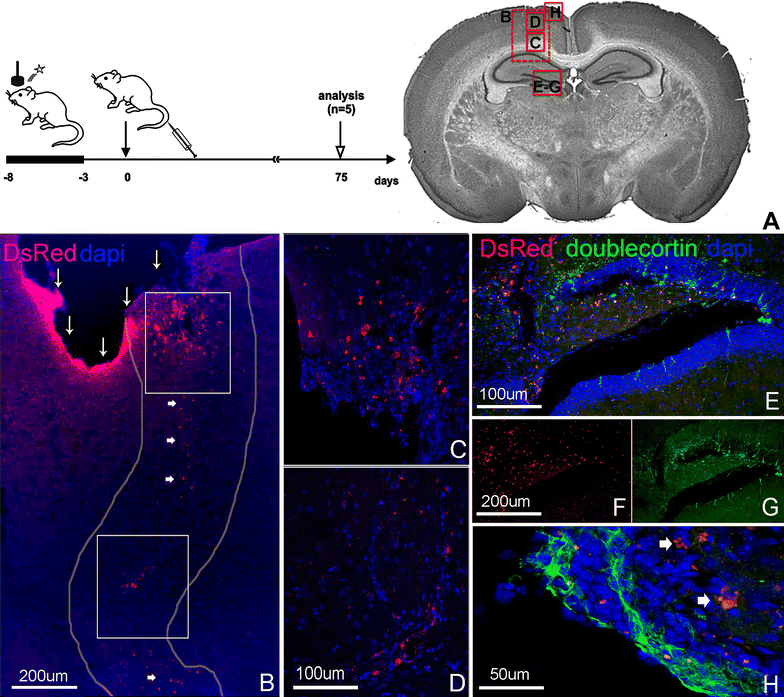Engraftment of enteric neural progenitor cells into the injured adult brain
- PMID: 26810757
- PMCID: PMC4727306
- DOI: 10.1186/s12868-016-0238-y
Engraftment of enteric neural progenitor cells into the injured adult brain
Abstract
Background: A major area of unmet need is the development of strategies to restore neuronal network systems and to recover brain function in patients with neurological disease. The use of cell-based therapies remains an attractive approach, but its application has been challenging due to the lack of suitable cell sources, ethical concerns, and immune-mediated tissue rejection. We propose an innovative approach that utilizes gut-derived neural tissue for cell-based therapies following focal or diffuse central nervous system injury.
Results: Enteric neuronal stem and progenitor cells, able to differentiate into neuronal and glial lineages, were isolated from the postnatal enteric nervous system and propagated in vitro. Gut-derived neural progenitors, genetically engineered to express fluorescent proteins, were transplanted into the injured brain of adult mice. Using different models of brain injury in combination with either local or systemic cell delivery, we show that transplanted enteric neuronal progenitor cells survive, proliferate, and differentiate into neuronal and glial lineages in vivo. Moreover, transplanted cells migrate extensively along neuronal pathways and appear to modulate the local microenvironment to stimulate endogenous neurogenesis.
Conclusions: Our findings suggest that enteric nervous system derived cells represent a potential source for tissue regeneration in the central nervous system. Further studies are needed to validate these findings and to explore whether autologous gut-derived cell transplantation into the injured brain can result in functional neurologic recovery.
Figures





Similar articles
-
Enteric neural progenitors are more efficient than brain-derived progenitors at generating neurons in the colon.Am J Physiol Gastrointest Liver Physiol. 2014 Oct 1;307(7):G741-8. doi: 10.1152/ajpgi.00225.2014. Epub 2014 Aug 14. Am J Physiol Gastrointest Liver Physiol. 2014. PMID: 25125684
-
Isogenic enteric neural progenitor cells can replace missing neurons and glia in mice with Hirschsprung disease.Neurogastroenterol Motil. 2016 Apr;28(4):498-512. doi: 10.1111/nmo.12744. Epub 2015 Dec 20. Neurogastroenterol Motil. 2016. PMID: 26685978 Free PMC article.
-
Delivery of enteric neural progenitors with 5-HT4 agonist-loaded nanoparticles and thermosensitive hydrogel enhances cell proliferation and differentiation following transplantation in vivo.Biomaterials. 2016 May;88:1-11. doi: 10.1016/j.biomaterials.2016.02.016. Epub 2016 Feb 17. Biomaterials. 2016. PMID: 26922325 Free PMC article.
-
Concise Review: Cellular and Molecular Mechanisms of Postnatal Injury-Induced Enteric Neurogenesis.Stem Cells. 2019 Sep;37(9):1136-1143. doi: 10.1002/stem.3045. Epub 2019 Jun 24. Stem Cells. 2019. PMID: 31145813 Review.
-
Cell therapy for GI motility disorders: comparison of cell sources and proposed steps for treating Hirschsprung disease.Am J Physiol Gastrointest Liver Physiol. 2017 Apr 1;312(4):G348-G354. doi: 10.1152/ajpgi.00018.2017. Epub 2017 Feb 16. Am J Physiol Gastrointest Liver Physiol. 2017. PMID: 28209600 Review.
Cited by
-
Present and future avenues of cell-based therapy for brain injury: The enteric nervous system as a potential cell source.Brain Pathol. 2022 Sep;32(5):e13105. doi: 10.1111/bpa.13105. Epub 2022 Jun 30. Brain Pathol. 2022. PMID: 35773942 Free PMC article. Review.
-
Peripheral nervous system: A promising source of neuronal progenitors for central nervous system repair.Front Neurosci. 2022 Jul 29;16:970350. doi: 10.3389/fnins.2022.970350. eCollection 2022. Front Neurosci. 2022. PMID: 35968387 Free PMC article. Review.
-
Transplanted enteric neural stem cells integrate within the developing chick spinal cord: implications for spinal cord repair.J Anat. 2018 Nov;233(5):592-606. doi: 10.1111/joa.12880. Epub 2018 Sep 7. J Anat. 2018. PMID: 30191559 Free PMC article.
-
Stem Cell Therapies for the Resolution of Radiation Injury to the Brain.Curr Stem Cell Rep. 2017 Dec;3(4):342-347. doi: 10.1007/s40778-017-0105-5. Epub 2017 Oct 11. Curr Stem Cell Rep. 2017. PMID: 29423356 Free PMC article.
-
Combined treatment with enteric neural stem cells and chondroitinase ABC reduces spinal cord lesion pathology.Stem Cell Res Ther. 2021 Jan 6;12(1):10. doi: 10.1186/s13287-020-02031-9. Stem Cell Res Ther. 2021. PMID: 33407795 Free PMC article.
References
-
- Gustavsson A, Svensson M, Jacobi F, Allgulander C, Alonso J, Beghi E, Dodel R, Ekman M, Faravelli C, Fratiglioni L, et al. Cost of disorders of the brain in Europe 2010. Euro Neuropsychopharmacol J Euro Coll Neuropsychopharmacol. 2011;21(10):718–779. doi: 10.1016/j.euroneuro.2011.08.008. - DOI - PubMed
-
- Wittchen HU, Jacobi F, Rehm J, Gustavsson A, Svensson M, Jonsson B, Olesen J, Allgulander C, Alonso J, Faravelli C, et al. The size and burden of mental disorders and other disorders of the brain in Europe 2010. Euro Neuropsychopharmacol J Euro Coll Neuropsychopharmacol. 2011;21(9):655–679. doi: 10.1016/j.euroneuro.2011.07.018. - DOI - PubMed
-
- Daviglus ML, Bell CC, Berrettini W, Bowen PE, Connolly ES, Jr, Cox NJ, Dunbar-Jacob JM, Granieri EC, Hunt G, McGarry K, et al. National Institutes of Health State-of-the-Science Conference statement: preventing alzheimer disease and cognitive decline. Ann Intern Med. 2010;153(3):176–181. doi: 10.7326/0003-4819-153-3-201008030-00260. - DOI - PubMed
-
- Saraceno B. Neurological disorders and public health challenges. In: Document WHO, editor. Geneva. Switzerland: World Health Organization Press; 2006. pp. 1–218.
MeSH terms
LinkOut - more resources
Full Text Sources
Other Literature Sources

